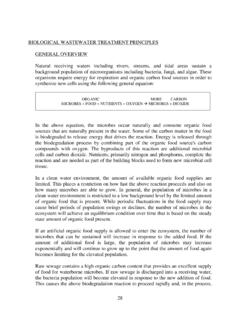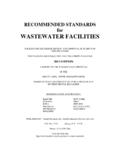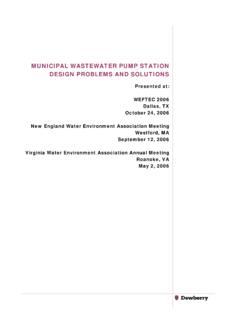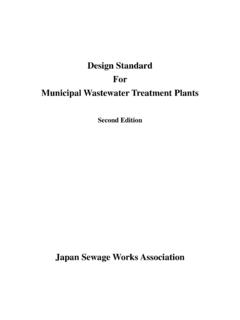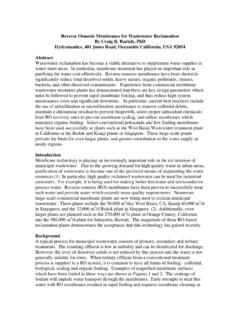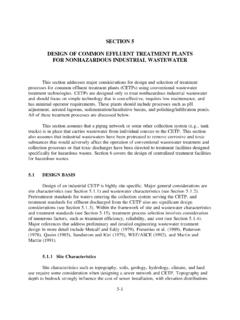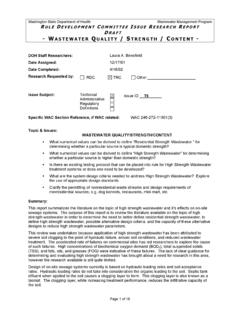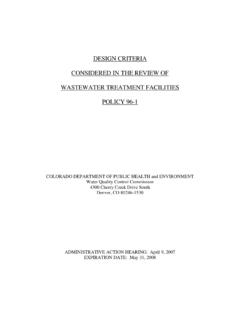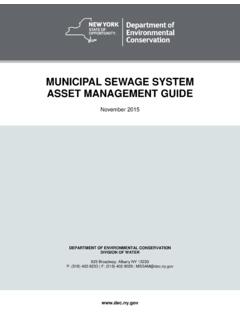Transcription of BIOLOGICAL WASTEWATER TREATMENT PRINCIPLES …
1 28 BIOLOGICAL WASTEWATER TREATMENT PRINCIPLES GENERAL OVERVIEW Natural receiving waters including rivers, streams, and tidal areas sustain a background population of microorganisms including bacteria, fungi, and algae. These organisms require energy for respiration and organic carbon food sources in order to synthesize new cells using the following general equation: ORGANIC MORE CARBON MICROBES + FOOD + NUTRIENTS + OXYGEN MICROBES + DIOXIDE In the above equation, the microbes occur naturally and consume organic food sources that are naturally present in the water. Some of the carbon matter in the food is biodegraded to release energy that drives the reaction.
2 Energy is released through the biodegradation process by combining part of the organic food source's carbon compounds with oxygen. The byproducts of this reaction are additional microbial cells and carbon dioxide. Nutrients, primarily nitrogen and phosphorus, complete the reaction and are needed as part of the building blocks used to form new microbial cell tissue. In a clean water environment, the amount of available organic food supplies are limited. This places a restriction on how fast the above reaction proceeds and also on how many microbes are able to grow. In general, the population of microbes in a clean water environment is restricted to a low background level by the limited amount of organic food that is present. While periodic fluctuations in the food supply may cause brief periods of population swings or declines, the number of microbes in the ecosystem will achieve an equilibrium condition over time that is based on the steady state amount of organic food present.
3 If an artificial organic food supply is allowed to enter the ecosystem, the number of microbes that can be sustained will increase in response to the added food. If the amount of additional food is large, the population of microbes may increase exponentially and will continue to grow up to the point that the amount of food again becomes limiting for the elevated population. Raw sewage contains a high organic carbon content that provides an excellent supply of food for waterborne microbes. If raw sewage is discharged into a receiving water, the bacteria population will become elevated in response to the new addition of food. This causes the above biodegradation reaction to proceed rapidly and, in the process, 29 to create larger amounts of new microbes and carbon dioxide.
4 This requires that more oxygen be available for use by the microbes. If sufficient extra food is added by the sewage discharge, the population of microorganisms and the resulting oxygen consumption may proceed so rapidly that all of the receiving water's oxygen is depleted. The maximum amount of dissolved oxygen present in a receiving water is a function of temperature, atmospheric pressure, elevation, the solids content of the water, and salinity. In any case, the saturation value of dissolved oxygen that is present is relatively small as shown below in Table 8. At sea level and 0 C, the maximum amount of dissolved oxygen that can be saturated into solution is mg/l. This value decreases to only mg/l at 30 C.
5 For this reason, there is less dissolved oxygen available in the summer when water temperatures are warmer than during the cold winter months. Unfortunately, high water temperatures will also stimulate microbial activity which will cause biodegradation reaction rates to increase and oxygen depletion to occur faster. This makes summertime the most critical period for maintaining dissolved oxygen conditions in receiving waters. Table 8 also shows the effect that salinity has on dissolved oxygen levels. As a receiving water becomes higher in chlorides, less oxygen can be dissolved into the water. TABLE 8: SATURATION VALUES OF DISSOLVED OXYGEN IN WATER DISSOLVED OXYGEN DISSOLVED OXYGEN TEMPERATURE IN FRESH WATER IN SALT WATER (0 C) (mg/l) (mg/l) 0 5 10 15 20 25 30 If free dissolved oxygen is present, the ecosystem is considered to be aerobic.
6 If excess raw sewage is discharged to a receiving water, the available food supply may result in a large microbial population that fully depletes all of the dissolved oxygen. This results in the system becoming anoxic or anaerobic. Since most fish and aquatic species require a minimum dissolved oxygen level of at least mg/l to survive, the depletion of all the dissolved oxygen is a serious environmental concern. Septic conditions also present a variety of other environmental problems including odor 30 generation, acidic compound formation and pH drops, lethal gas generation, and explosive environments. The origin of these septic system issues can be reviewed by considering the data shown on Table 9. Microbes in the ecosystem can use other oxidizing compounds besides oxygen in the biodegradation reaction.
7 Other suitable oxidizing agents include nitrate, sulfates, and carbon dioxide. Bacteria prefer to use oxygen because more energy is released than if other compounds are used. This energy allows the bacteria to degrade the food supply more completely and at a faster rate. The carbon dioxide that is released as a byproduct is natural to the environment and innocuous. Should all of the oxygen be depleted, other types of microbes will take over the system and use other compounds to degrade the organic matter. These alternative reactions result in less energy being released which slows down the TREATMENT reaction rate or results in less complete TREATMENT in the same reaction time. As shown in Table 9, some of the by-products produced by these alternative reactions are less desirable than the carbon dioxide produced when oxygen is used.
8 TABLE 9: ORGANIC BIODEGRADATION REACTION PRODUCTS TYPE OF OXIDIZING UNIT ENERGY BYPRODUCTS ISSUES WITH SYSTEM COMPOUND RELEASED FORMED BYPRODUCTS (Kcal/mole) Aerobic Oxygen Carbon dioxide None Anoxic Nitrate Nitrogen gas Rising solids Anaerobic Sulfate Hydrogen sulfide Odorous, Corrosive, and Toxic Anaerobic Carbon Dioxide Methane Odorous, Explosive, and Toxic Oxygen is the oxidizing agent of choice in microbial biodegradation because it results in high energy yields and harmless byproducts. Nitrate results in nearly the same energy yield, but produces nitrogen gas that can float solids in receiving waters or TREATMENT systems.
9 Sulfur or carbon dioxide compounds can be used to biodegrade organic matter under septic conditions; however, extremely low energy yields result and hydrogen sulfide or methane gas is produced. These gases are odorous, corrosive, explosive, and toxic. They contribute to acid formation and pH reductions as well as unsafe environmental conditions. Bacteria in the ecosystem will always use oxygen 31 first if it is available and, in doing so, will avoid the types of adverse byproducts shown in Table 9. Should all of the oxygen be depleted, the ecosystem will continue to biodegrade the organic food supply by converting to an anoxic or anaerobic environment. In these cases, adverse environmental effects will be created. The discussion on microbes up to this point has focussed on naturally occurring bacteria and other microorganisms that are simply biodegrading organic compounds.
10 It is important to note that raw sewage discharges into a receiving water also present additional problems from harmful human enteric microbes, called pathogens, that can spread waterborne diseases to humans. The WASTEWATER discharge from a community will contain a representative sampling of all diseases that exist within the general population of sewer users. The presence of these diseases is usually assessed by measuring the amount of E. coli or fecal coliform bacteria that are present in the raw sewage. These organisms serve as indicators of upstream human waste contamination. If the indicator organisms are present, it can be assumed that harmful disease causing pathogens are also present. Given the possibility of downstream human contact or shellfish contamination, the presence of pathogens in a raw sewage discharge represents a serious environmental health concern.
